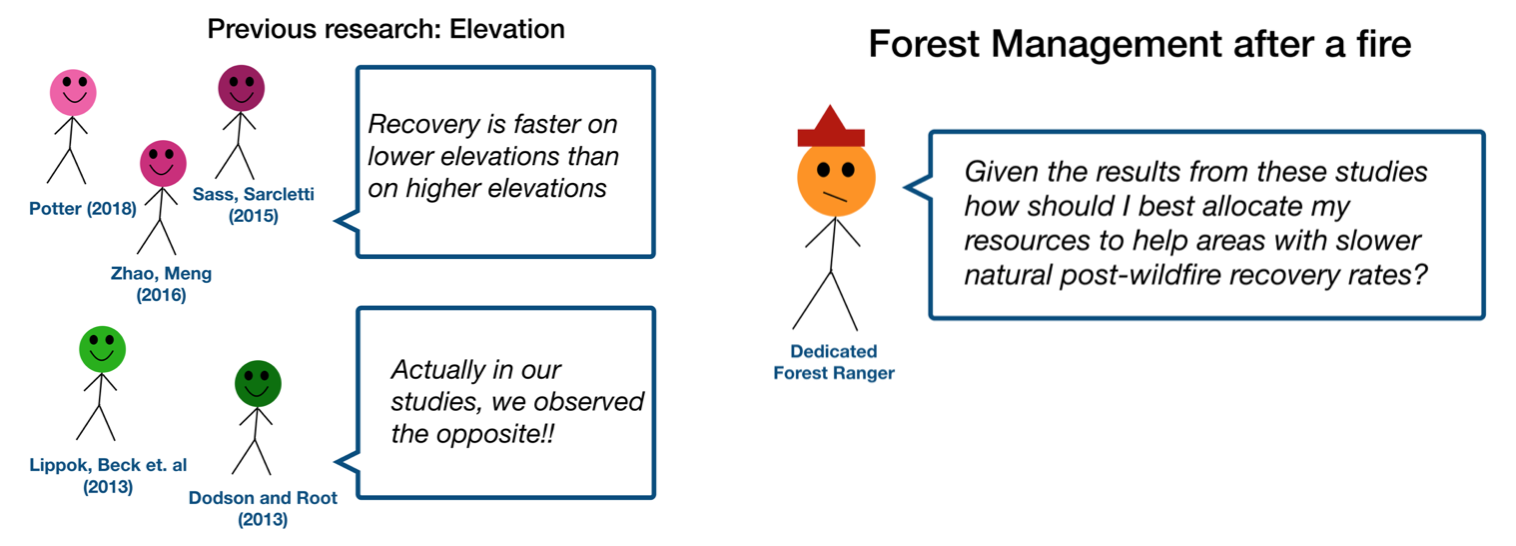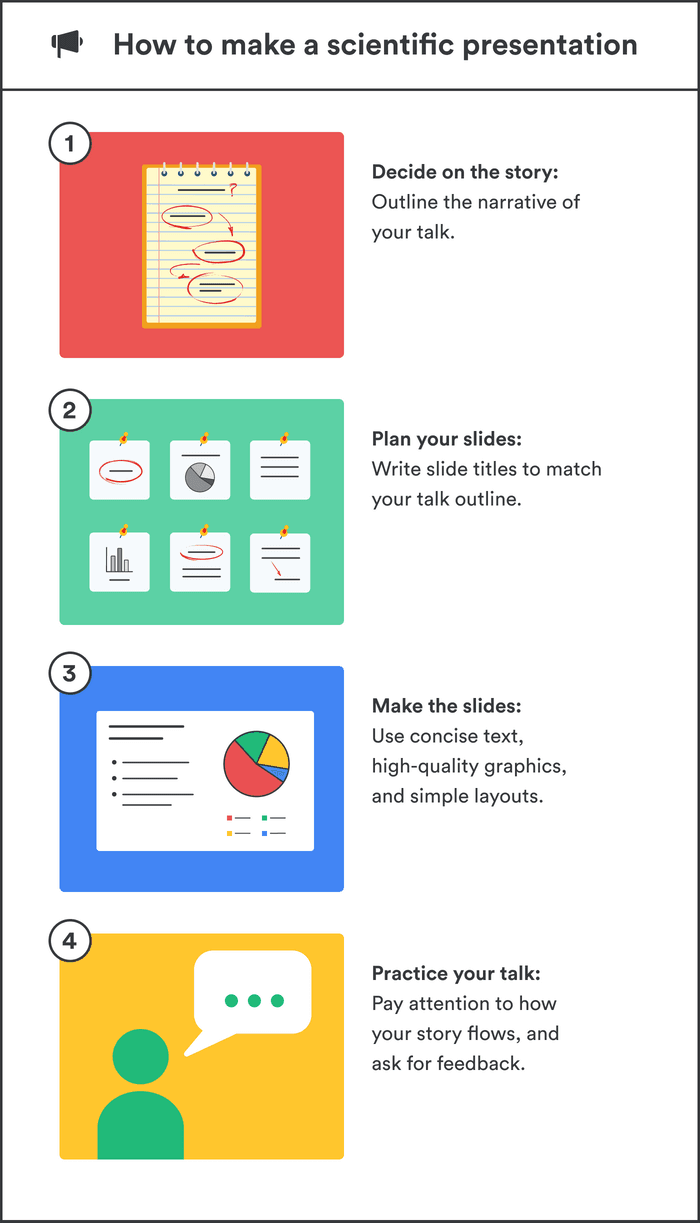

Making a short presentation based on your research: 11 tips
Markus goldstein, david evans.
Over the past few weeks, we’ve both spent a fair amount of time at conferences. Given that many conferences ask researchers to summarize their work in 15 to 20 minutes, we thought we’d reflect on some ideas for how to do this, and – more importantly – how to do it well.
- You have 15 minutes. That’s not enough time to use the slides you used for that recent 90-minute academic seminar. One recent presentation one of us saw had 52 slides for 15 minutes. No amount of speed talking will get you through this in anything resembling coherence. (And quit speed talking, anyway. This isn’t a FedEx commercial !) There is no magic number of slides since the content you’ll have and how you talk will vary. But if you have more than 15 slides, then #2 is doubly important.
- Practice. This is the great thing about a 15-minute talk: You can actually afford to run through it, out loud. Running through it once in advance can reveal to you – wow! – that it’s actually a 25-minute talk and you need to cut a bunch. Of course, the first time through the presentation it may take a bit longer than you will when you present, but if you have any doubts, practice again (bringing your prep time to a whopping 30 minutes plus a little bit).
- You need a (short) narrative. What is the main story you are trying to tell with this paper? Fifteen minutes works better for communicating a narrative then for taking an audience through every twist and turn of your econometric grandeur. Deciding on your narrative will help with the discipline in the points that follow.
- A model or results? Even if your audience is all academics, you don’t have academic seminar time. So the first thing to do is to figure out which is more important to get across – your model or your empirical results. Then trim the other one down to one slide, max. If the results are your focus (usually the case for us), give the audience a sense of how the model is set up, and what the main implications are as they pertain to the results you will show. Conversely, if it’s the model that’s more important, the empirical results will come later and you can just give the very brief highlights that bolster the key points.
- The literature. Really, really minimal. If you do it at all, choose only the papers that you are either going to build on in a major way or contradict. For some types of discussants, it may help to include them, even if they don’t meet the other criteria. Marc Bellemare takes an even stronger stance: “Never, ever have a literature review in your slides. If literature reviews are boring to read in papers, they are insanely boring to listen to during presentations.”
- Program details. Here it’s a bit of a balance. The audience needs a flavor for the program, they need to understand what it did and how it’s different from other things (particularly other things with some kinds of evidence). But only in exceptional cases (as in, it’s a really different program for theoretical reasons, or you don’t have more than process results yet) do you want this to eat up a lot of your time.
- You don’t have time to go through the nitty gritty of the data. We get that every detail about the survey was fascinating (we spend a lot of our lives thinking about this). But if it’s not key to the story, save it for a longer presentation (or another paper). And if you’re doing a primarily theoretical paper, this is a bullet on one slide.
- Balance and summary stats. Key summary stats that tell the audience who the people are might make the cut, but 3 slides of every variable that you’ll use are going to be slides you either rip through (telling the audience nothing) or waste most of your time on. Summarize the summary stats. On balance tests: you are either balanced or not. If you are, this gets a bullet at most (you can also just say that). If you’re not, tell us what’s up and why we should or should not worry.
- Pre-analysis plan. If you had it, mention it (quickly). If not, don’t. It’s not critical here.
- A picture may be worth 1,000 numbers. Sometimes, taking that really packed table which is currently in 12 point font and turning it into a graph is going to help you with self-control and help your audience with comprehension. Put the significant results in a bar chart, and use asterisks to tell folks which are significant.
- A special warning about presenting your job market paper. When I (Markus) submitted my job market paper to a journal, the referee report came back noting that this was surely a job market paper since it had 40(!) tables. Key example of how everything matters when you just spent four years of your life collecting each observation. Discipline. You have (or will have) an elevator pitch from the job market – use this to trim your presentation.
- Marc Bellemare has a great series of “22 tips for conference and seminar presentations,” many of which apply to short presentations: “Always provide a preview of your results. This isn’t a murder mystery: it’s only when people know where you’re taking them that they can enjoy the scenery along the way.”
- Jeff Leek has a great guide to giving presentations of different lengths, and what your goal should be: “As a scientist, it is hard to accept that the primary purpose of a talk is advertising, not science.” This is doubly true for a 15-minute talk.
- The AEA Committee on the Status of Women in the Economics Profession has a top 10 list. “Never cut and paste a table from your paper onto a slide. These tables are never easy to read and only irritate your audience. Instead, choose a few results that you want to highlight and present them on a slide in no smaller than 28 font.” We’ve pretty much all done this. It’s bad practice. (“I’m sorry you can’t read this table.” “Oh really, then why did you cut and paste that giant table from your paper into the presentation?!”)
- I (Dave) go back and re-read Jesse Shapiro’s guide on “ How to Give an Applied Micro Talk ” from time to time. It’s more geared toward a full-length seminar, but the advice is so good I can’t resist plugging it here.
Get updates from Development Impact
Thank you for choosing to be part of the Development Impact community!
Your subscription is now active. The latest blog posts and blog-related announcements will be delivered directly to your email inbox. You may unsubscribe at any time.

Lead Economist, Africa Gender Innovation Lab and Chief Economists Office

Senior Fellow, Center for Global Development
Join the Conversation
- Share on mail
- comments added

Princeton Correspondents on Undergraduate Research
How to Make a Successful Research Presentation
Turning a research paper into a visual presentation is difficult; there are pitfalls, and navigating the path to a brief, informative presentation takes time and practice. As a TA for GEO/WRI 201: Methods in Data Analysis & Scientific Writing this past fall, I saw how this process works from an instructor’s standpoint. I’ve presented my own research before, but helping others present theirs taught me a bit more about the process. Here are some tips I learned that may help you with your next research presentation:
More is more
In general, your presentation will always benefit from more practice, more feedback, and more revision. By practicing in front of friends, you can get comfortable with presenting your work while receiving feedback. It is hard to know how to revise your presentation if you never practice. If you are presenting to a general audience, getting feedback from someone outside of your discipline is crucial. Terms and ideas that seem intuitive to you may be completely foreign to someone else, and your well-crafted presentation could fall flat.
Less is more
Limit the scope of your presentation, the number of slides, and the text on each slide. In my experience, text works well for organizing slides, orienting the audience to key terms, and annotating important figures–not for explaining complex ideas. Having fewer slides is usually better as well. In general, about one slide per minute of presentation is an appropriate budget. Too many slides is usually a sign that your topic is too broad.

Limit the scope of your presentation
Don’t present your paper. Presentations are usually around 10 min long. You will not have time to explain all of the research you did in a semester (or a year!) in such a short span of time. Instead, focus on the highlight(s). Identify a single compelling research question which your work addressed, and craft a succinct but complete narrative around it.
You will not have time to explain all of the research you did. Instead, focus on the highlights. Identify a single compelling research question which your work addressed, and craft a succinct but complete narrative around it.
Craft a compelling research narrative
After identifying the focused research question, walk your audience through your research as if it were a story. Presentations with strong narrative arcs are clear, captivating, and compelling.
- Introduction (exposition — rising action)
Orient the audience and draw them in by demonstrating the relevance and importance of your research story with strong global motive. Provide them with the necessary vocabulary and background knowledge to understand the plot of your story. Introduce the key studies (characters) relevant in your story and build tension and conflict with scholarly and data motive. By the end of your introduction, your audience should clearly understand your research question and be dying to know how you resolve the tension built through motive.

- Methods (rising action)
The methods section should transition smoothly and logically from the introduction. Beware of presenting your methods in a boring, arc-killing, ‘this is what I did.’ Focus on the details that set your story apart from the stories other people have already told. Keep the audience interested by clearly motivating your decisions based on your original research question or the tension built in your introduction.
- Results (climax)
Less is usually more here. Only present results which are clearly related to the focused research question you are presenting. Make sure you explain the results clearly so that your audience understands what your research found. This is the peak of tension in your narrative arc, so don’t undercut it by quickly clicking through to your discussion.
- Discussion (falling action)
By now your audience should be dying for a satisfying resolution. Here is where you contextualize your results and begin resolving the tension between past research. Be thorough. If you have too many conflicts left unresolved, or you don’t have enough time to present all of the resolutions, you probably need to further narrow the scope of your presentation.
- Conclusion (denouement)
Return back to your initial research question and motive, resolving any final conflicts and tying up loose ends. Leave the audience with a clear resolution of your focus research question, and use unresolved tension to set up potential sequels (i.e. further research).
Use your medium to enhance the narrative
Visual presentations should be dominated by clear, intentional graphics. Subtle animation in key moments (usually during the results or discussion) can add drama to the narrative arc and make conflict resolutions more satisfying. You are narrating a story written in images, videos, cartoons, and graphs. While your paper is mostly text, with graphics to highlight crucial points, your slides should be the opposite. Adapting to the new medium may require you to create or acquire far more graphics than you included in your paper, but it is necessary to create an engaging presentation.
The most important thing you can do for your presentation is to practice and revise. Bother your friends, your roommates, TAs–anybody who will sit down and listen to your work. Beyond that, think about presentations you have found compelling and try to incorporate some of those elements into your own. Remember you want your work to be comprehensible; you aren’t creating experts in 10 minutes. Above all, try to stay passionate about what you did and why. You put the time in, so show your audience that it’s worth it.
For more insight into research presentations, check out these past PCUR posts written by Emma and Ellie .
— Alec Getraer, Natural Sciences Correspondent
Share this:
- Share on Tumblr

- Research Process
- Manuscript Preparation
- Manuscript Review
- Publication Process
- Publication Recognition
- Language Editing Services
- Translation Services

How to Make a PowerPoint Presentation of Your Research Paper
- 4 minute read
- 143.3K views
Table of Contents
A research paper presentation is often used at conferences and in other settings where you have an opportunity to share your research, and get feedback from your colleagues. Although it may seem as simple as summarizing your research and sharing your knowledge, successful research paper PowerPoint presentation examples show us that there’s a little bit more than that involved.
In this article, we’ll highlight how to make a PowerPoint presentation from a research paper, and what to include (as well as what NOT to include). We’ll also touch on how to present a research paper at a conference.
Purpose of a Research Paper Presentation
The purpose of presenting your paper at a conference or forum is different from the purpose of conducting your research and writing up your paper. In this setting, you want to highlight your work instead of including every detail of your research. Likewise, a presentation is an excellent opportunity to get direct feedback from your colleagues in the field. But, perhaps the main reason for presenting your research is to spark interest in your work, and entice the audience to read your research paper.
So, yes, your presentation should summarize your work, but it needs to do so in a way that encourages your audience to seek out your work, and share their interest in your work with others. It’s not enough just to present your research dryly, to get information out there. More important is to encourage engagement with you, your research, and your work.
Tips for Creating Your Research Paper Presentation
In addition to basic PowerPoint presentation recommendations, which we’ll cover later in this article, think about the following when you’re putting together your research paper presentation:
- Know your audience : First and foremost, who are you presenting to? Students? Experts in your field? Potential funders? Non-experts? The truth is that your audience will probably have a bit of a mix of all of the above. So, make sure you keep that in mind as you prepare your presentation.
Know more about: Discover the Target Audience .
- Your audience is human : In other words, they may be tired, they might be wondering why they’re there, and they will, at some point, be tuning out. So, take steps to help them stay interested in your presentation. You can do that by utilizing effective visuals, summarize your conclusions early, and keep your research easy to understand.
- Running outline : It’s not IF your audience will drift off, or get lost…it’s WHEN. Keep a running outline, either within the presentation or via a handout. Use visual and verbal clues to highlight where you are in the presentation.
- Where does your research fit in? You should know of work related to your research, but you don’t have to cite every example. In addition, keep references in your presentation to the end, or in the handout. Your audience is there to hear about your work.
- Plan B : Anticipate possible questions for your presentation, and prepare slides that answer those specific questions in more detail, but have them at the END of your presentation. You can then jump to them, IF needed.
What Makes a PowerPoint Presentation Effective?
You’ve probably attended a presentation where the presenter reads off of their PowerPoint outline, word for word. Or where the presentation is busy, disorganized, or includes too much information. Here are some simple tips for creating an effective PowerPoint Presentation.
- Less is more: You want to give enough information to make your audience want to read your paper. So include details, but not too many, and avoid too many formulas and technical jargon.
- Clean and professional : Avoid excessive colors, distracting backgrounds, font changes, animations, and too many words. Instead of whole paragraphs, bullet points with just a few words to summarize and highlight are best.
- Know your real-estate : Each slide has a limited amount of space. Use it wisely. Typically one, no more than two points per slide. Balance each slide visually. Utilize illustrations when needed; not extraneously.
- Keep things visual : Remember, a PowerPoint presentation is a powerful tool to present things visually. Use visual graphs over tables and scientific illustrations over long text. Keep your visuals clean and professional, just like any text you include in your presentation.
Know more about our Scientific Illustrations Services .
Another key to an effective presentation is to practice, practice, and then practice some more. When you’re done with your PowerPoint, go through it with friends and colleagues to see if you need to add (or delete excessive) information. Double and triple check for typos and errors. Know the presentation inside and out, so when you’re in front of your audience, you’ll feel confident and comfortable.
How to Present a Research Paper
If your PowerPoint presentation is solid, and you’ve practiced your presentation, that’s half the battle. Follow the basic advice to keep your audience engaged and interested by making eye contact, encouraging questions, and presenting your information with enthusiasm.
We encourage you to read our articles on how to present a scientific journal article and tips on giving good scientific presentations .
Language Editing Plus
Improve the flow and writing of your research paper with Language Editing Plus. This service includes unlimited editing, manuscript formatting for the journal of your choice, reference check and even a customized cover letter. Learn more here , and get started today!

Know How to Structure Your PhD Thesis

Systematic Literature Review or Literature Review?
You may also like.

What is a Good H-index?

What is a Corresponding Author?

How to Submit a Paper for Publication in a Journal
Input your search keywords and press Enter.
Reference management. Clean and simple.
How to make a scientific presentation

Scientific presentation outlines
Questions to ask yourself before you write your talk, 1. how much time do you have, 2. who will you speak to, 3. what do you want the audience to learn from your talk, step 1: outline your presentation, step 2: plan your presentation slides, step 3: make the presentation slides, slide design, text elements, animations and transitions, step 4: practice your presentation, final thoughts, frequently asked questions about preparing scientific presentations, related articles.
A good scientific presentation achieves three things: you communicate the science clearly, your research leaves a lasting impression on your audience, and you enhance your reputation as a scientist.
But, what is the best way to prepare for a scientific presentation? How do you start writing a talk? What details do you include, and what do you leave out?
It’s tempting to launch into making lots of slides. But, starting with the slides can mean you neglect the narrative of your presentation, resulting in an overly detailed, boring talk.
The key to making an engaging scientific presentation is to prepare the narrative of your talk before beginning to construct your presentation slides. Planning your talk will ensure that you tell a clear, compelling scientific story that will engage the audience.
In this guide, you’ll find everything you need to know to make a good oral scientific presentation, including:
- The different types of oral scientific presentations and how they are delivered;
- How to outline a scientific presentation;
- How to make slides for a scientific presentation.
Our advice results from delving into the literature on writing scientific talks and from our own experiences as scientists in giving and listening to presentations. We provide tips and best practices for giving scientific talks in a separate post.
There are two main types of scientific talks:
- Your talk focuses on a single study . Typically, you tell the story of a single scientific paper. This format is common for short talks at contributed sessions in conferences.
- Your talk describes multiple studies. You tell the story of multiple scientific papers. It is crucial to have a theme that unites the studies, for example, an overarching question or problem statement, with each study representing specific but different variations of the same theme. Typically, PhD defenses, invited seminars, lectures, or talks for a prospective employer (i.e., “job talks”) fall into this category.
➡️ Learn how to prepare an excellent thesis defense
The length of time you are allotted for your talk will determine whether you will discuss a single study or multiple studies, and which details to include in your story.
The background and interests of your audience will determine the narrative direction of your talk, and what devices you will use to get their attention. Will you be speaking to people specializing in your field, or will the audience also contain people from disciplines other than your own? To reach non-specialists, you will need to discuss the broader implications of your study outside your field.
The needs of the audience will also determine what technical details you will include, and the language you will use. For example, an undergraduate audience will have different needs than an audience of seasoned academics. Students will require a more comprehensive overview of background information and explanations of jargon but will need less technical methodological details.
Your goal is to speak to the majority. But, make your talk accessible to the least knowledgeable person in the room.
This is called the thesis statement, or simply the “take-home message”. Having listened to your talk, what message do you want the audience to take away from your presentation? Describe the main idea in one or two sentences. You want this theme to be present throughout your presentation. Again, the thesis statement will depend on the audience and the type of talk you are giving.
Your thesis statement will drive the narrative for your talk. By deciding the take-home message you want to convince the audience of as a result of listening to your talk, you decide how the story of your talk will flow and how you will navigate its twists and turns. The thesis statement tells you the results you need to show, which subsequently tells you the methods or studies you need to describe, which decides the angle you take in your introduction.
➡️ Learn how to write a thesis statement
The goal of your talk is that the audience leaves afterward with a clear understanding of the key take-away message of your research. To achieve that goal, you need to tell a coherent, logical story that conveys your thesis statement throughout the presentation. You can tell your story through careful preparation of your talk.
Preparation of a scientific presentation involves three separate stages: outlining the scientific narrative, preparing slides, and practicing your delivery. Making the slides of your talk without first planning what you are going to say is inefficient.
Here, we provide a 4 step guide to writing your scientific presentation:
- Outline your presentation
- Plan your presentation slides
- Make the presentation slides
- Practice your presentation

Writing an outline helps you consider the key pieces of your talk and how they fit together from the beginning, preventing you from forgetting any important details. It also means you avoid changing the order of your slides multiple times, saving you time.
Plan your talk as discrete sections. In the table below, we describe the sections for a single study talk vs. a talk discussing multiple studies:
The following tips apply when writing the outline of a single study talk. You can easily adapt this framework if you are writing a talk discussing multiple studies.
Introduction: Writing the introduction can be the hardest part of writing a talk. And when giving it, it’s the point where you might be at your most nervous. But preparing a good, concise introduction will settle your nerves.
The introduction tells the audience the story of why you studied your topic. A good introduction succinctly achieves four things, in the following order.
- It gives a broad perspective on the problem or topic for people in the audience who may be outside your discipline (i.e., it explains the big-picture problem motivating your study).
- It describes why you did the study, and why the audience should care.
- It gives a brief indication of how your study addressed the problem and provides the necessary background information that the audience needs to understand your work.
- It indicates what the audience will learn from the talk, and prepares them for what will come next.
A good introduction not only gives the big picture and motivations behind your study but also concisely sets the stage for what the audience will learn from the talk (e.g., the questions your work answers, and/or the hypotheses that your work tests). The end of the introduction will lead to a natural transition to the methods.
Give a broad perspective on the problem. The easiest way to start with the big picture is to think of a hook for the first slide of your presentation. A hook is an opening that gets the audience’s attention and gets them interested in your story. In science, this might take the form of a why, or a how question, or it could be a statement about a major problem or open question in your field. Other examples of hooks include quotes, short anecdotes, or interesting statistics.
Why should the audience care? Next, decide on the angle you are going to take on your hook that links to the thesis of your talk. In other words, you need to set the context, i.e., explain why the audience should care. For example, you may introduce an observation from nature, a pattern in experimental data, or a theory that you want to test. The audience must understand your motivations for the study.
Supplementary details. Once you have established the hook and angle, you need to include supplementary details to support them. For example, you might state your hypothesis. Then go into previous work and the current state of knowledge. Include citations of these studies. If you need to introduce some technical methodological details, theory, or jargon, do it here.
Conclude your introduction. The motivation for the work and background information should set the stage for the conclusion of the introduction, where you describe the goals of your study, and any hypotheses or predictions. Let the audience know what they are going to learn.
Methods: The audience will use your description of the methods to assess the approach you took in your study and to decide whether your findings are credible. Tell the story of your methods in chronological order. Use visuals to describe your methods as much as possible. If you have equations, make sure to take the time to explain them. Decide what methods to include and how you will show them. You need enough detail so that your audience will understand what you did and therefore can evaluate your approach, but avoid including superfluous details that do not support your main idea. You want to avoid the common mistake of including too much data, as the audience can read the paper(s) later.
Results: This is the evidence you present for your thesis. The audience will use the results to evaluate the support for your main idea. Choose the most important and interesting results—those that support your thesis. You don’t need to present all the results from your study (indeed, you most likely won’t have time to present them all). Break down complex results into digestible pieces, e.g., comparisons over multiple slides (more tips in the next section).
Summary: Summarize your main findings. Displaying your main findings through visuals can be effective. Emphasize the new contributions to scientific knowledge that your work makes.
Conclusion: Complete the circle by relating your conclusions to the big picture topic in your introduction—and your hook, if possible. It’s important to describe any alternative explanations for your findings. You might also speculate on future directions arising from your research. The slides that comprise your conclusion do not need to state “conclusion”. Rather, the concluding slide title should be a declarative sentence linking back to the big picture problem and your main idea.
It’s important to end well by planning a strong closure to your talk, after which you will thank the audience. Your closing statement should relate to your thesis, perhaps by stating it differently or memorably. Avoid ending awkwardly by memorizing your closing sentence.
By now, you have an outline of the story of your talk, which you can use to plan your slides. Your slides should complement and enhance what you will say. Use the following steps to prepare your slides.
- Write the slide titles to match your talk outline. These should be clear and informative declarative sentences that succinctly give the main idea of the slide (e.g., don’t use “Methods” as a slide title). Have one major idea per slide. In a YouTube talk on designing effective slides , researcher Michael Alley shows examples of instructive slide titles.
- Decide how you will convey the main idea of the slide (e.g., what figures, photographs, equations, statistics, references, or other elements you will need). The body of the slide should support the slide’s main idea.
- Under each slide title, outline what you want to say, in bullet points.
In sum, for each slide, prepare a title that summarizes its major idea, a list of visual elements, and a summary of the points you will make. Ensure each slide connects to your thesis. If it doesn’t, then you don’t need the slide.
Slides for scientific presentations have three major components: text (including labels and legends), graphics, and equations. Here, we give tips on how to present each of these components.
- Have an informative title slide. Include the names of all coauthors and their affiliations. Include an attractive image relating to your study.
- Make the foreground content of your slides “pop” by using an appropriate background. Slides that have white backgrounds with black text work well for small rooms, whereas slides with black backgrounds and white text are suitable for large rooms.
- The layout of your slides should be simple. Pay attention to how and where you lay the visual and text elements on each slide. It’s tempting to cram information, but you need lots of empty space. Retain space at the sides and bottom of your slides.
- Use sans serif fonts with a font size of at least 20 for text, and up to 40 for slide titles. Citations can be in 14 font and should be included at the bottom of the slide.
- Use bold or italics to emphasize words, not underlines or caps. Keep these effects to a minimum.
- Use concise text . You don’t need full sentences. Convey the essence of your message in as few words as possible. Write down what you’d like to say, and then shorten it for the slide. Remove unnecessary filler words.
- Text blocks should be limited to two lines. This will prevent you from crowding too much information on the slide.
- Include names of technical terms in your talk slides, especially if they are not familiar to everyone in the audience.
- Proofread your slides. Typos and grammatical errors are distracting for your audience.
- Include citations for the hypotheses or observations of other scientists.
- Good figures and graphics are essential to sustain audience interest. Use graphics and photographs to show the experiment or study system in action and to explain abstract concepts.
- Don’t use figures straight from your paper as they may be too detailed for your talk, and details like axes may be too small. Make new versions if necessary. Make them large enough to be visible from the back of the room.
- Use graphs to show your results, not tables. Tables are difficult for your audience to digest! If you must present a table, keep it simple.
- Label the axes of graphs and indicate the units. Label important components of graphics and photographs and include captions. Include sources for graphics that are not your own.
- Explain all the elements of a graph. This includes the axes, what the colors and markers mean, and patterns in the data.
- Use colors in figures and text in a meaningful, not random, way. For example, contrasting colors can be effective for pointing out comparisons and/or differences. Don’t use neon colors or pastels.
- Use thick lines in figures, and use color to create contrasts in the figures you present. Don’t use red/green or red/blue combinations, as color-blind audience members can’t distinguish between them.
- Arrows or circles can be effective for drawing attention to key details in graphs and equations. Add some text annotations along with them.
- Write your summary and conclusion slides using graphics, rather than showing a slide with a list of bullet points. Showing some of your results again can be helpful to remind the audience of your message.
- If your talk has equations, take time to explain them. Include text boxes to explain variables and mathematical terms, and put them under each term in the equation.
- Combine equations with a graphic that shows the scientific principle, or include a diagram of the mathematical model.
- Use animations judiciously. They are helpful to reveal complex ideas gradually, for example, if you need to make a comparison or contrast or to build a complicated argument or figure. For lists, reveal one bullet point at a time. New ideas appearing sequentially will help your audience follow your logic.
- Slide transitions should be simple. Silly ones distract from your message.
- Decide how you will make the transition as you move from one section of your talk to the next. For example, if you spend time talking through details, provide a summary afterward, especially in a long talk. Another common tactic is to have a “home slide” that you return to multiple times during the talk that reinforces your main idea or message. In her YouTube talk on designing effective scientific presentations , Stanford biologist Susan McConnell suggests using the approach of home slides to build a cohesive narrative.
To deliver a polished presentation, it is essential to practice it. Here are some tips.
- For your first run-through, practice alone. Pay attention to your narrative. Does your story flow naturally? Do you know how you will start and end? Are there any awkward transitions? Do animations help you tell your story? Do your slides help to convey what you are saying or are they missing components?
- Next, practice in front of your advisor, and/or your peers (e.g., your lab group). Ask someone to time your talk. Take note of their feedback and the questions that they ask you (you might be asked similar questions during your real talk).
- Edit your talk, taking into account the feedback you’ve received. Eliminate superfluous slides that don’t contribute to your takeaway message.
- Practice as many times as needed to memorize the order of your slides and the key transition points of your talk. However, don’t try to learn your talk word for word. Instead, memorize opening and closing statements, and sentences at key junctures in the presentation. Your presentation should resemble a serious but spontaneous conversation with the audience.
- Practicing multiple times also helps you hone the delivery of your talk. While rehearsing, pay attention to your vocal intonations and speed. Make sure to take pauses while you speak, and make eye contact with your imaginary audience.
- Make sure your talk finishes within the allotted time, and remember to leave time for questions. Conferences are particularly strict on run time.
- Anticipate questions and challenges from the audience, and clarify ambiguities within your slides and/or speech in response.
- If you anticipate that you could be asked questions about details but you don’t have time to include them, or they detract from the main message of your talk, you can prepare slides that address these questions and place them after the final slide of your talk.
➡️ More tips for giving scientific presentations
An organized presentation with a clear narrative will help you communicate your ideas effectively, which is essential for engaging your audience and conveying the importance of your work. Taking time to plan and outline your scientific presentation before writing the slides will help you manage your nerves and feel more confident during the presentation, which will improve your overall performance.
A good scientific presentation has an engaging scientific narrative with a memorable take-home message. It has clear, informative slides that enhance what the speaker says. You need to practice your talk many times to ensure you deliver a polished presentation.
First, consider who will attend your presentation, and what you want the audience to learn about your research. Tailor your content to their level of knowledge and interests. Second, create an outline for your presentation, including the key points you want to make and the evidence you will use to support those points. Finally, practice your presentation several times to ensure that it flows smoothly and that you are comfortable with the material.
Prepare an opening that immediately gets the audience’s attention. A common device is a why or a how question, or a statement of a major open problem in your field, but you could also start with a quote, interesting statistic, or case study from your field.
Scientific presentations typically either focus on a single study (e.g., a 15-minute conference presentation) or tell the story of multiple studies (e.g., a PhD defense or 50-minute conference keynote talk). For a single study talk, the structure follows the scientific paper format: Introduction, Methods, Results, Summary, and Conclusion, whereas the format of a talk discussing multiple studies is more complex, but a theme unifies the studies.
Ensure you have one major idea per slide, and convey that idea clearly (through images, equations, statistics, citations, video, etc.). The slide should include a title that summarizes the major point of the slide, should not contain too much text or too many graphics, and color should be used meaningfully.

- Google Slides Presentation Design
- Pitch Deck Design
- Powerpoint Redesign
- Other Design Services

- Guide & How to's
- How to present a research paper in PPT: best practices
A research paper presentation is frequently used at conferences and other events where you have a chance to share the results of your research and receive feedback from colleagues. Although it may appear as simple as summarizing the findings, successful examples of research paper presentations show that there is a little bit more to it.
In this article, we’ll walk you through the basic outline and steps to create a good research paper presentation. We’ll also explain what to include and what not to include in your presentation of research paper and share some of the most effective tips you can use to take your slides to the next level.
Research paper PowerPoint presentation outline
Creating a PowerPoint presentation for a research paper involves organizing and summarizing your key findings, methodology, and conclusions in a way that encourages your audience to interact with your work and share their interest in it with others. Here’s a basic research paper outline PowerPoint you can follow:
1. Title (1 slide)
Typically, your title slide should contain the following information:
- Title of the research paper
- Affiliation or institution
- Date of presentation
2. Introduction (1-3 slides)
On this slide of your presentation, briefly introduce the research topic and its significance and state the research question or objective.
3. Research questions or hypothesis (1 slide)
This slide should emphasize the objectives of your research or present the hypothesis.
4. Literature review (1 slide)
Your literature review has to provide context for your research by summarizing relevant literature. Additionally, it should highlight gaps or areas where your research contributes.
5. Methodology and data collection (1-2 slides)
This slide of your research paper PowerPoint has to explain the research design, methods, and procedures. It must also Include details about participants, materials, and data collection and emphasize special equipment you have used in your work.
6. Results (3-5 slides)
On this slide, you must present the results of your data analysis and discuss any trends, patterns, or significant findings. Moreover, you should use charts, graphs, and tables to illustrate data and highlight something novel in your results (if applicable).
7. Conclusion (1 slide)
Your conclusion slide has to summarize the main findings and their implications, as well as discuss the broader impact of your research. Usually, a single statement is enough.
8. Recommendations (1 slide)
If applicable, provide recommendations for future research or actions on this slide.
9. References (1-2 slides)
The references slide is where you list all the sources cited in your research paper.
10. Acknowledgments (1 slide)
On this presentation slide, acknowledge any individuals, organizations, or funding sources that contributed to your research.
11. Appendix (1 slide)
If applicable, include any supplementary materials, such as additional data or detailed charts, in your appendix slide.
The above outline is just a general guideline, so make sure to adjust it based on your specific research paper and the time allotted for the presentation.
Steps to creating a memorable research paper presentation
Creating a PowerPoint presentation for a research paper involves several critical steps needed to convey your findings and engage your audience effectively, and these steps are as follows:
Step 1. Understand your audience:
- Identify the audience for your presentation.
- Tailor your content and level of detail to match the audience’s background and knowledge.
Step 2. Define your key messages:
- Clearly articulate the main messages or findings of your research.
- Identify the key points you want your audience to remember.
Step 3. Design your research paper PPT presentation:
- Use a clean and professional design that complements your research topic.
- Choose readable fonts, consistent formatting, and a limited color palette.
- Opt for PowerPoint presentation services if slide design is not your strong side.
Step 4. Put content on slides:
- Follow the outline above to structure your presentation effectively; include key sections and topics.
- Organize your content logically, following the flow of your research paper.
Step 5. Final check:
- Proofread your slides for typos, errors, and inconsistencies.
- Ensure all visuals are clear, high-quality, and properly labeled.
Step 6. Save and share:
- Save your presentation and ensure compatibility with the equipment you’ll be using.
- If necessary, share a copy of your presentation with the audience.
By following these steps, you can create a well-organized and visually appealing research paper presentation PowerPoint that effectively conveys your research findings to the audience.
What to include and what not to include in your presentation
In addition to the must-know PowerPoint presentation recommendations, which we’ll cover later in this article, consider the following do’s and don’ts when you’re putting together your research paper presentation:
- Focus on the topic.
- Be brief and to the point.
- Attract the audience’s attention and highlight interesting details.
- Use only relevant visuals (maps, charts, pictures, graphs, etc.).
- Use numbers and bullet points to structure the content.
- Make clear statements regarding the essence and results of your research.
Don’ts:
- Don’t write down the whole outline of your paper and nothing else.
- Don’t put long, full sentences on your slides; split them into smaller ones.
- Don’t use distracting patterns, colors, pictures, and other visuals on your slides; the simpler, the better.
- Don’t use too complicated graphs or charts; only the ones that are easy to understand.
- Now that we’ve discussed the basics, let’s move on to the top tips for making a powerful presentation of your research paper.

8 tips on how to make research paper presentation that achieves its goals
You’ve probably been to a presentation where the presenter reads word for word from their PowerPoint outline. Or where the presentation is cluttered, chaotic, or contains too much data. The simple tips below will help you summarize a 10 to 15-page paper for a 15 to 20-minute talk and succeed, so read on!
Tip #1: Less is more
You want to provide enough information to make your audience want to know more. Including details but not too many and avoiding technical jargon, formulas, and long sentences are always good ways to achieve this.
Tip #2: Be professional
Avoid using too many colors, font changes, distracting backgrounds, animations, etc. Bullet points with a few words to highlight the important information are preferable to lengthy paragraphs. Additionally, include slide numbers on all PowerPoint slides except for the title slide, and make sure it is followed by a table of contents, offering a brief overview of the entire research paper.
Tip #3: Strive for balance
PowerPoint slides have limited space, so use it carefully. Typically, one to two points per slide or 5 lines for 5 words in a sentence are enough to present your ideas.
Tip #4: Use proper fonts and text size
The font you use should be easy to read and consistent throughout the slides. You can go with Arial, Times New Roman, Calibri, or a combination of these three. An ideal text size is 32 points, while a heading size is 44.
Tip #5: Concentrate on the visual side
A PowerPoint presentation is one of the best tools for presenting information visually. Use graphs instead of tables and topic-relevant illustrations instead of walls of text. Keep your visuals as clean and professional as the content of your presentation.
Tip #6: Practice your delivery
Always go through your presentation when you’re done to ensure a smooth and confident delivery and time yourself to stay within the allotted limit.
Tip #7: Get ready for questions
Anticipate potential questions from your audience and prepare thoughtful responses. Also, be ready to engage in discussions about your research.
Tip #8: Don’t be afraid to utilize professional help
If the mere thought of designing a presentation overwhelms you or you’re pressed for time, consider leveraging professional PowerPoint redesign services . A dedicated design team can transform your content or old presentation into effective slides, ensuring your message is communicated clearly and captivates your audience. This way, you can focus on refining your delivery and preparing for the presentation.
Lastly, remember that even experienced presenters get nervous before delivering research paper PowerPoint presentations in front of the audience. You cannot know everything; some things can be beyond your control, which is completely fine. You are at the event not only to share what you know but also to learn from others. So, no matter what, dress appropriately, look straight into the audience’s eyes, try to speak and move naturally, present your information enthusiastically, and have fun!
If you need help with slide design, get in touch with our dedicated design team and let qualified professionals turn your research findings into a visually appealing, polished presentation that leaves a lasting impression on your audience. Our experienced designers specialize in creating engaging layouts, incorporating compelling graphics, and ensuring a cohesive visual narrative that complements content on any subject.
- Presenting techniques
- 50 tips on how to improve PowerPoint presentations in 2022-2023 [Updated]
- Present financial information visually in PowerPoint to drive results
- Keynote VS PowerPoint
👀 Turn any prompt into captivating visuals in seconds with our AI-powered design generator ✨ Try Piktochart AI!
7 Best Practices to a Standout Research Presentation

After months of rigorous analysis, interpretation, and synthesis, your research findings are ready to change the world (or at least your corner of it).
Now comes the next challenge: how do you translate your complex insights into a compelling research presentation that not only informs but captivates your audience?
Keep reading for tips and best practices to create a research presentation as confident as your findings.
Pro tip : Get your free Piktochart account before you scroll down. This way, you can immediately put our tips to practice as you read along. Alternatively, you can hop over to our AI presentation maker and find more examples of professional research presentation decks.
Keep your pen and paper handy so you can take notes!
What exactly happens during a research presentation?
When you present your research, you share what you’ve been working on and what you found out.
You start by explaining why your topic matters, then walk your audience through how you went about investigating it. Then, you share your results, often with visuals to make things clear. You wrap up by recapping your main points, talking about what your findings and their relevance, and pointing out any questions that still need to be answered.
In a nutshell, your research presentation is a way to get your work out there, get people talking, and maybe even gain new perspectives.
How long is a typical research presentation?
The ideal length of a research presentation depends on the specific context, audience, and purpose. Here’s a general guideline:
- Short and sweet (10-15 minutes): Perfect for giving your audience a taste of your research and sparking their interest.
- Standard fare (20-30 minutes): Enough time to dive deeper into your methods and findings, ideal for most academic settings.
- Deep dive (45-60+ minutes): A comprehensive look at your work. This is best for specialized audiences who want all the details of your research.
How about an AP research presentation? How long should it be?
The official time limit for an AP (Advanced Placement) Research presentation is 15 to 20 minutes. But here’s a quick tip: you won’t want to use every second of that. Effective presenters often aim for the lower end of this range because shorter yet well-organized presentations hold attention and leave room for questions.
Aim for an AP research presentation that’s around 12-15 minutes, leaving a few minutes for questions or discussion. This keeps things engaging and shows you respect your audience’s time. As you’ll see later below, some of the best winning presentations we’ve found online are just 3 minutes long!
Speaking of, let’s get into the nitty-gritty of designing successful, effective research presentations.
Beyond bullet points: How to create research presentations that stand out
First time presenters often fall into the trap of relying on endless bullet points and dry recitations of data. As tempting as this sounds to effectively organize your presentation, it can often look like you’ve just copied and pasted your paper into the slides, and you’ll end up reading off them verbatim.
Here are some best practices with accompanying research presentation examples to help you go beyond bullet points and leave a lasting impression the next time you present your research.
1. Develop a narrative for your research.
Let’s be honest, nobody wants to sit through a data dump disguised as a presentation. Instead, think of your research as a compelling story. Every good story has the following elements:
- Exposition: Set the scene for your research. What’s the problem you’re tackling? Why is your topic important? Use this section to create a compelling rationale that resonates with your audience’s interests or the broader implications of your work.
- Rising action (The challenge): Build tension and intrigue. What challenges did you face? What unexpected twists and turns did your research take? This is where you describe your research approach and the obstacles encountered, giving you a chance to inject some excitement into the research while demonstrating your problem-solving skills.
- Climax (Results): Reveal your findings! This is the moment your audience has been waiting for. This is the best time to use visuals to make your results memorable.
- Falling Action (Unpacking the results)): Help your audience make sense of your results. What are the broader implications? Are there potential applications, policy impacts, or do the results advance the theoretical understanding in your field?
- Resolution: Wrap it up with a satisfying conclusion. What are the next steps? What questions remain unanswered? End your presentation on a high note. Summarize your key takeaways, offer a call to action, or pose thought-provoking questions for future research. This leaves your audience wanting more.
A great example of a research presentation following a narrative arc is this 3-minute presentation by Shannon Lea Watkins of the University of California San Francisco. It won 1st place (Poster Presentation category) for APPAM’s (Association for Public Analysis and Management) 2017 Fall Research Conference.
The presentation skillfully introduces the research question, “Does initiating tobacco use with flavored products predict current smoking status? An examination by race, gender, and sexual identity,” and builds anticipation for the findings. The subsequent discussion of the research’s implications also effectively engages the audience and highlights its significance.
In just 3 minutes, the presenter communicated the core message using clear language and highlighted the key takeaways.
2. Use a font size that is legible from a distance.
Imagine your grandmother sitting in the back row. Would she be able to read your slides comfortably?
If not, it’s time to bump up your presentation slide’s font size. A good rule of thumb is to use a minimum font size of 24 points for body text and 36 points for headings.
In addition, white space is your friend. Don’t overcrowd your slides with too much text. Instead, use concise bullet points, phrases, or keywords to guide your narrative. This will keep your audience focused on your story and not squinting to read tiny texts.
Dr. Oliver Hauser’s presentation of his winning paper on “Minority Report: A Modern Perspective on Reducing Unethical Behavior in Organizations” is a good example of a presentation with legible text. The black text on a white background also creates excellent contrast which makes the text easily readable.
3. Choose your fonts carefully.
Now that you’ve taken care of your presentations’ font size, let’s talk about font types. So what’s the best font for research presentations?
When choosing the right font for your research presentation, consider the “personality” of different fonts and choose ones that align with your research’s tone and topic. For example, serif fonts are traditional and classic, while sans serif fonts are modern and clean.
It also helps to prioritize legibility over style, especially for body text. Finally, don’t be afraid to mix and match fonts for visual interest.
Here’s a pro tip from Stephanie Lee , Lead Designer at Piktochart:
“An important factor to consider when choosing fonts to use is to ensure it has good readability. Roboto is a good font to consider for presentations, it’s a reliable font that’s versatile in that it can be used for both headings and body copy. It’s a great option if you need your design to look professional & modern.”
If you want to get creative, consider exploring less common fonts that still maintain readability. Some popular choices include:
- Futura : A geometric sans serif font with a modern feel.
- Raleway : A versatile sans serif font that works well for both headings and body text.
- Libre Baskerville : A classic serif font with excellent readability.
- Poppins : A geometric sans serif font with a friendly and approachable vibe.
Recommended reading : 14 Fonts That Make Your PowerPoint Presentations Stand Out
How about font pairings for presentations?
Here are some general tips to help you with font pairings and create a professional and visually-appealing research presentation:
- Pair a serif font with a sans serif font: This classic combination offers a nice contrast between traditional and modern styles.
- Use a bold or decorative font for headings and a simple font for body text: This creates a clear hierarchy and helps your audience navigate your content.
- Limit your font choices to two or three: Using too many fonts can make your presentation look cluttered and unprofessional.
And here are some popular font pairings you can try when making your own presentation :
Classic and readable
- Heading: Georgia or Merriweather (serif)
- Body: Arial or Helvetica (sans-serif)
This combination is timeless and easy on the eyes. It works well for formal presentations and those with a lot of text.
Modern and clean
- Heading: Montserrat or Lato (sans-serif)
- Body: Open Sans or Roboto (sans-serif)
These fonts are sleek and contemporary. They are suitable for presentations with a minimalist design and those targeting a younger audience.
Creative and engaging
- Heading: Playfair Display or Lobster (serif)
- Body: Raleway or Oswald (sans-serif)
This pairing is visually interesting and can help capture attention. This combo is ideal for creative presentations and those focused on design or storytelling.
With Piktochart, finding the right font for your presentation is very straightforward. You’ve got many options right at your fingertips, and you can even upload your own if you want to make it more custom. This makes it easier to customize your research presentation slides and make them look sharp!

4. Choose a color palette that complements your presentation.
Your presentation slides’ color scheme sets the mood of your presentation and can even influence how your audience perceives your message. Here are some pointers to help you pick the righ t color palette :
Match it to your topic
The colors you choose should reflect the tone of your research. Calming blues and green palette combinations might work for a mental health presentation, while fiery reds and oranges could be better for discussing climate change.
Keep it simple
Don’t overwhelm your audience with a rainbow of colors. Following the rule of 3 is a safe approach; stick to a primary color, a secondary color, and maybe an accent color.
Consider color psychology
The color you choose for your presentation can evoke emotions. For example, blue often signifies trust while green can represent growth.
Here are some more examples to get you started:
- Scientific and academic: Use white, gray, black, with a pop of blue or green.
- Business and corporate: Use blues, grays, and a touch of gold.
- Creative and artistic: Go for vibrant colors like orange, yellow, or turquoise.
- Nonprofit and social Impact: Opt for earthy tones like brown or green, with a warm accent like orange.
If you’re still not sure if you can get your presentation’s color scheme right, Piktochart makes it easier for you with its Color Schemes feature. It allows you to apply a set of colors to your entire presentation slide in one click.
Piktochart offers two types of Color Schemes for your presentations:
- Suggested: These are pre-designed palettes curated by Piktochart’s designers and are available in most templates. Access them by clicking on the “Colors” option in the editor.
- Brand: Business plan users can create custom color schemes with up to six colors. These can be manually created or extracted from an image. To create a brand color scheme, go to “Brand” and click on “Create Brand Color Scheme”.
You can edit both types of color schemes by clicking the pencil icon.

This AP research presentation by Madeline Hart showcases the link between birth order and overall creativity.
Notice how Madeline incorporates vivid colors into her slides. Vivid colors like orange and yellow green are associated with creativity, energy, and enthusiasm. By using these colors, Madeline subtly reinforces her presentation’s theme and creates a visually stimulating experience for her audience.
In addition, while Madeline uses pops of color, her overall slide design likely remains clean and uncluttered. This allows her audience to focus on the content without being overwhelmed by excessive visuals or text.
5. Guide your audience with smooth, engaging transitions
Transitions should enhance, not overpower, your presentation. Smooth transitions between slides can make your presentation feel polished and professional. Avoid abrupt jumps or jarring effects. Use subtle fades, slides, or dissolves to maintain a sense of flow and continuity. It’s also worth noting that shorter transitions may feel energetic, while longer ones create a thoughtful atmosphere.
The good news is that Piktochart offers a range of slide transitions to improve the flow and visual appeal of your presentation. Here are some transition effects you can try:
- None: A simple, static transition with no animation.
- Default: Piktochart’s standard transition, usually a subtle fade or slide.
- Concave: A unique transition where the previous slide appears to bend inwards as the next slide takes its place.
- Fade: A gradual transition where the previous slide fades out as the next slide fades in.
- Linear: A simple, horizontal slide transition.
- Zoom: A dynamic transition where the next slide appears to zoom in from a distance.
Experiment with these transitions to find what best suits your research presentation. Learn more about these Piktochart transitions.
6. Remember the 5/5/5 Rule
The 5/5/5 Rule in presentation design is a simple yet powerful guideline designed to prevent your slides from becoming overwhelming walls of text. Here’s a breakdown of the rule:
- 5 lines of text: Aim to keep the text on each slide to a maximum of five lines. This helps prevent information overload and ensures that your key points are easily digestible.
- 5 words per line: Limit each line of text to approximately five words. This makes your slides easier to read and prevents your audience from getting lost in long sentences or complex ideas.
- 5 text-heavy slides: Avoid presenting more than five consecutive slides that are predominantly text-based. Break up the monotony with visuals, graphs, or interactive elements to maintain audience engagement.
Can you break the 5/5/5 Rule? Of course! It’s a guideline, not a law.
There may be times when you need to exceed these limits, such as when presenting complex data or detailed information. However, always strive for clarity and conciseness. If you must include a lot of text, consider using bullet points, breaking up the information into multiple slides, or providing handouts for your audience to reference later.
7. Test your presentation slides on different devices
Your meticulously crafted presentation might look flawless on your laptop screen, but that doesn’t guarantee it will translate well to other viewing environments like on a projector or smartphone.
Testing your slides on various devices is crucial because screen sizes, resolutions, and even operating systems can drastically alter how your presentation appears.
Here’s a quick checklist you can use:
- Your laptop/desktop
- Projector (if using)
- Smartphone (iOS and Android)
- Tablet (iPad or Android)
- Check in both standard and presentation modes.
- Zoom in and out to simulate different viewing distances.
- Test in different web browsers if you’re using online presentation software .
- Get feedback from others viewing your presentation on their devices.
Testing your research presentation on different devices is easy with Piktochart, thanks to its handy share URL feature. With just a few clicks, you can generate a unique link to your presentation and easily share it with colleagues, friends, or anyone else you’d like to get feedback from.
Here’s how it works:

- Create your presentation in Piktochart.
- Click the “Share” button.
- Select “Public on the Web” and click “Copy Link”
- Send the URL to your reviewers.
They can then access your presentation on their own devices and give valuable feedback on how it looks and functions across different screen sizes and platforms. It’s a simple, efficient way to ensure your presentation is polished and accessible to all audiences.
Make impactful research presentations slides with Piktochart
We’ve covered a lot of ground on how to turn your research into a presentation that’ll grab your audience’s attention and leave a lasting impact.
The takeaway here is it’s not just about the facts and figures—it’s about telling a story, being mindful of your fonts, smooth transitions, and keeping things concise. Testing your slides on different devices is a pro move too.
Don’t let your research findings go unnoticed—use Piktochart’s presentation maker to create impactful and thoughtful research presentations. Get your Piktochart free plan if you haven’t yet!

Other Posts

7 Sales Presentation Examples for Successful Pitches

How to Make a Presentation (Guide With Tips & Templates)

How to Nail Your Brand Presentation: Examples and Pro Tips

IMAGES
VIDEO
COMMENTS
What is the main story you are trying to tell with this paper? Fifteen minutes works better for communicating a narrative then for taking an audience through every twist and turn of your econometric grandeur.
Presentations with strong narrative arcs are clear, captivating, and compelling. Introduction (exposition — rising action) Orient the audience and draw them in by demonstrating the relevance and importance of your research story with strong global motive.
In this article, we’ll highlight how to make a PowerPoint presentation from a research paper, and what to include (as well as what NOT to include). We’ll also touch on how to present a research paper at a conference.
This guide provides a 4-step process for making a good scientific presentation: outlining the scientific narrative, preparing slide outlines, constructing slides, and practicing the talk. We give advice on how to make effective slides, including tips for text, graphics, and equations, and how to use rehearsals of your talk to refine your ...
Creating a PowerPoint presentation for a research paper involves organizing and summarizing your key findings, methodology, and conclusions in a way that encourages your audience to interact with your work and share their interest in it with others.
You wrap up by recapping your main points, talking about what your findings and their relevance, and pointing out any questions that still need to be answered. In a nutshell, your research presentation is a way to get your work out there, get people talking, and maybe even gain new perspectives.